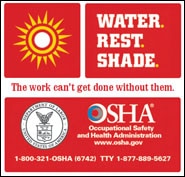
The Campaign

Dangers of Working in the Heat
Every year, dozens of workers die and thousands more become ill while working in extreme heat or humid conditions. More than 40 percent of heat-related worker deaths occur in the construction industry, but workers in every field are susceptible. There are a range of heat illnesses and they can affect anyone, regardless of age or physical condition.
Heat-related Illnesses and First Aid
Heat stroke, the most serious form of heat-related illness, happens when the body becomes unable to regulate its core temperature. Sweating stops and the body can no longer rid itself of excess heat.
Symptoms: Signs include confusion, loss of consciousness and seizures.
First Aid: Heat stroke is a medical emergency that may result in death! Call 911 immediately. While waiting for help place the worker in a shady and cool area; loosen clothing and remove outer clothing; fan air on the worker and place cold packs in armpits; wet the worker with cool water; provide fluids (preferably water) as soon as possible and stay with the worker until help arrives.
Heat exhaustion is the body’s response to loss of water and salt from heavy sweating.
Symptoms: Signs include headache, nausea or vomiting, dizziness, weakness, light headedness, irritability, thirst and heavy sweating.
First aid for heat exhaustion includes: have the worker sit or lie down in a cool, shady area; give the worker plenty of water or other cool beverages to drink; cool the worker with cold compresses or ice packs; if symptoms worsen or do not improve within 60 minutes, take the worker to a clinic or emergency room for evaluation; the worker should not return to work that day.
Heat cramps are caused by the loss of body salts and fluid during sweating. Low salt levels in muscles cause painful cramps. Tired muscles—those used for performing the work—are usually the ones most affected by cramps. Cramps may occur during or after working hours.
Symptoms include muscle spasms, pain usually in the abdomen, arms or legs
First aid for heat cramps include: have worker rest in a shady, cool area; worker should drink water or other cool beverages; wait a few hours before allowing the worker to return to strenuous work; have worker seek medical attention if cramps don’t go away.
Heat rash, also known as prickly heat, is skin irritation caused by sweat that does not evaporate from the skin. Heat rash is the most common problem in hot work environments.
Symptoms include clusters of red bumps on the skin, often appearing on the neck, upper chest and in folds of skin.
First aid includes keeping the worker in a cooler, less humid environment when possible and keeping the affected area dry.
Employer Responsibility to Protect Workers
Under OSHA law, employers are responsible for providing workplaces free of known safety hazards. This includes protecting workers from extreme heat. An employer with workers exposed to high temperatures should establish a complete heat illness prevention program.
- Provide workers with water, rest and shade.
- Allow new or returning workers to gradually increase workloads and take more frequent breaks as they acclimatize, or build a tolerance for working in the heat.
- Plan for emergencies and train workers on prevention.
- Monitor workers for signs of illness.
Resources
OSHA’s Occupational Exposure to Heat page explains what employers can do to keep workers safe and what workers need to know – including factors for heat illness, adapting to working in indoor and outdoor heat, protecting workers, recognizing symptoms and first aid training. Also look for heat illness educational and training materials on OSHA’s Publications page.
Related News
- New Jersey Train Length, Crew Size Law Awaits Governor’s Signature
- CSX Conductor, Single Mother Devastated in Head-on Collision
- GP Coleman’s 2025 holiday message to members
- SOFA Safety Alert
- AJFL Scholarship Application Opens Soon
- SMART-TD Applauds FRA and DOT for Strengthening Cross-Border Rail Safety Protections
- Michigan sheet metal worker details impact of canceled project
- Regional Training Seminars coming to St. Paul, Baltimore in 2026
- SMART leaders train to bargain better contracts in Atlanta
- Chicago-area SMART members win big with transit funding bill